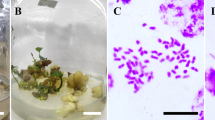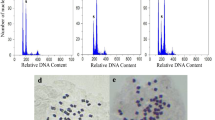Abstract
Centella asiatica—a medicinal plant that produces high-value active triterpenoids—is in increasing demand by the pharmaceutical and cosmetic industries. The aim of this study was to field-test one induced tetraploid and three diploid C. asiatica lines for the selection of high-quality plants with high phytomass and triterpenoid content and to determine their optimal harvesting time. All tested C. asiatica were micropropagated using an established protocol. One-month-old plantlets were acclimatized for the field experiment. The plants were grown in a randomized complete block design (RCBD) with three replications, ten plantlets per replication, and the experimental bed site was 0.6 × 1.0 m. Growth parameters, phytomass and the amounts of four active triterpenoids were evaluated. All lines exhibited the highest growth, yields and triterpenoids at 4 months after cultivation. The tetraploid line showed significantly better characteristics, i.e., larger leaf area, leaf width, petiole length, and greater yields, than diploid lines. Dry weight per cultivated area (77.53 ± 3.07 g/m2) and total triterpenoids (15.38 ± 0.76 % dry weight) were increased significantly in tetraploid plants of C. asiatica. Furthermore, the harvesting time had an effect on the yield and triterpenoid content (P < 0.001). In all tetraploid and diploid lines, the yields and triterpenoid content per cultivated area reached their maximum at 4 months after planting. Our results demonstrated that polyploidy induction is a beneficial tool that can be used to improve the medicinal value of C. asiatica.



Similar content being viewed by others
References
Widgerow AD, Chait LA, Stals R, Stals PJ (2000) New innovations in scar management. Aesthet Plast Surg 24:227–234
World Health Organization (1999) WHO monograph on selected medicinal plant, vol 1. World Health Organization, Geneva, pp 77–85
Guo JS, Cheng CL, Koo MWL (2004) Inhibitory effects of Centella asiatica water extract and asiaticoside on inducible nitric oxide synthase during gastric ulcer healing in rats. Planta Med 70:1150–1154
Wijeweera P, Arnason JT, Koszycki D, Merali Z (2006) Evaluation of anxiolytic properties of Gotukola (Centella asiatica) extracts and asiaticoside in rat behavioral models. Phytomedicine 13:668–676
Liang X, Huang YN, Chen SW, Wang WJ, Xu N, Cui S (2008) Antidepressant-like effect of asiaticoside in mice. Pharmacol Biochem Behav 89:444–449
Wattanathorn J, Mator L, Muchimapura S, Tongun T, Pasuriwong O, Piyawatkul N, Yimtae K, Sripanidkulchai B, Singkhoraard J (2008) Positive modulation of cognition and mood in the healthy elderly volunteer following the administration of Centella asiatica. J Ethnopharmacol 116:325–332
Kim OT, Kim MY, Hong MH, Ahn JC (2004) Stimulation of asiaticoside accumulation in the whole plant cultures of Centella asiatica (L.) Urban by elicitors. Plant Cell Rep 23:339–344
Kim OT, Bang KH, Shin YS, Lee MJ, Lung SJ, Hyun DY, Kim YC, Seong NS, Cha SW, Hwang B (2007) Enhanced production of asiaticoside from hairy root cultures of Centella asiatica (L.) Urban elicited by methyl jasmonate. Plant Cell Rep 26:1941–1949
Aziz ZA, Davey MR, Power JB, Anthony P, Smith RM, Lowe KC (2007) Production of asiaticoside and madecassoside in Centella asiatica in vitro and in vivo. Biol Plant 51(1):34–42
James JT, Meyer R, Dubery TA (2008) Characterization of two phenotypes of Centella asiatica in Southern Africa through the composition of four triterpenoids in callus, cell suspension and leaves. Plant Cell Tissue Organ Cult 94:91–99
Devkota A, Dall AS, Comai S, Innocenti G, Jha PK (2010) Centella asiatica (L.) Urban from Nepal: quali-quantitative analysis of samples from several sites, and selection of high terpene containing populations for cultivation. Biochem Syst Ecol 38:12–22
Randriamampionona D, Diallo B, Rakotoniriana F, Rabemanantsoa C, Cheuk K, Corbisie AM, Mahillon J, Ratsimamanga S, Jaziri ME (2007) Comparative analysis of active constituents in Centella asiatica samples from Madagascar: application for ex situ conservation and clonal propagation. Fitotherapia 78:482–489
Kaensaksiri T, Soontornchainaksaeng P, Soonthornchareonnon N, Prathanturarug S (2011) In vitro induction of polyploidy in Centella asiatica (L.) Urban. Plant Cell Tiss Organ Cult 107:187–194
Murashige T, Skoog F (1962) A revised medium for rapid growth and bioassays with tobacco tissue cultures. Physiol Plant 15:473–497
Kaensaksiri T, Soontornchainaksaeng P, Soonthornchareonnon N, Prathanturarug S (2011) In vitro clonal propagation of Centella asiatica (L.) Urban using shoot tip explants pre-treated with thidiazuron. Med Plant 3:47–52
Kobayashi N, Yamashita S, Ohta K, Hosoki T (2008) Morphological characteristics and their inheritance in colchicines-induced Salvia polyploids. J Jpn Soc Hortic Sci 77:186–191
Tang ZQ, Chen DL, Song ZJ, He YC, Cai DT (2010) In vitro induction and identification of tetraploid plants of Paulownia tomentosa. Plant Cell Tissue Organ Cult 102:213–220
Zhang W, Hao H, Ma L, Zhao C, Yu X (2010) Tetraploid muskmelon alters morphological characteristics and improves fruit quality. Sci Hortic Amsterdam 125:396–400
Ferrie AMR, Bethune TD, Arganosa GC, Waterer D (2011) Field evaluation of double haploid plants in the Apiceae: dill (Anethum graveolens L.), caraway (Carum carvi L.) and fennel (Foeniculum vulgare Mill.). Plant Cell Tiss Organ Cult 104:407–413
Prasad A, Pragadheesh VS, Mathur A, Srivasatava NK, Singh M, Mathur AK (2012) Growth and centelloside production in hydroponically established medicinal plant-Centella asiatica (L.). Ind Crop Prod 35:309–312
Acknowledgments
This research was supported by the Institutional Strengthening Program, Mahidol University, and the Chao Phya Abhaibhubejhr Hospital Foundation.
Author information
Authors and Affiliations
Corresponding author
Rights and permissions
About this article
Cite this article
Thong-on, W., Arimatsu, P., Pitiporn, S. et al. Field evaluation of in vitro-induced tetraploid and diploid Centella asiatica (L.) Urban. J Nat Med 68, 267–273 (2014). https://doi.org/10.1007/s11418-013-0761-4
Received:
Accepted:
Published:
Issue Date:
DOI: https://doi.org/10.1007/s11418-013-0761-4




